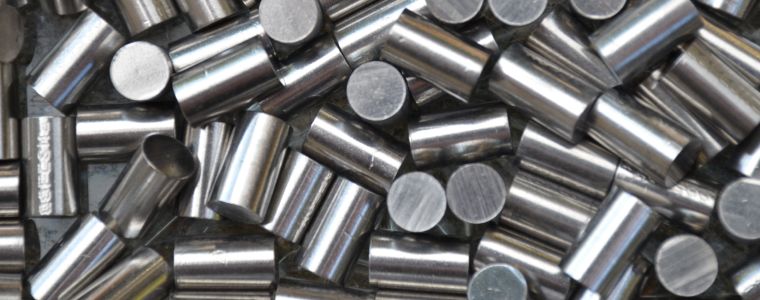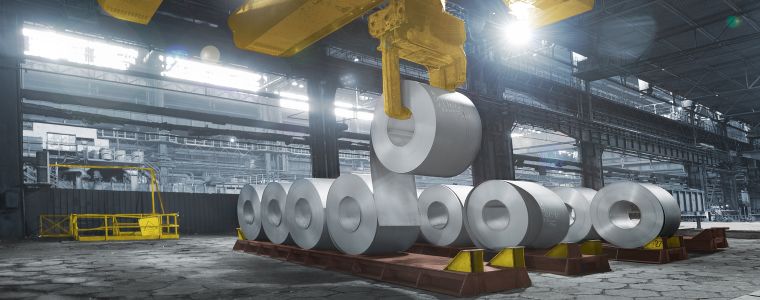A Guide to Nickel Alloys: Exploring Properties, Applications and Advantages

What is Nickel?
Nickel is a metallic element known for its versatility and strength in the world of chemistry. The following properties make nickel a versatile and indispensable material, driving innovation and progress across a wide range of sectors

✓Nickel has strong corrosion resistance and its magnetic qualities are integral to the functioning of numerous electronic devices and equipment. Its corrosion resistance ensures longevity in corrosive environments like chemical processing and marine settings.
✓The strength of nickel plays a critical role in components used in applications demanding structural integrity, notably in aerospace and power generation.
✓Nickel possesses magnetic properties, making it essential in electronic devices and equipment. This electrical conductivity adds to its utility, making it crucial in electrical connectors and components.
✓Its exceptional heat resistance makes it ideal for high-temperature applications like gas turbines and nuclear reactors.
Nickel’s Melting Point and Physical Properties
Nickel’s melting point is a defining feature that holds significant implications in high-temperature applications. With a melting point of approximately 1,455 degrees Celsius (2,651 degrees Fahrenheit), nickel exhibits remarkable stability at elevated temperatures. This property makes it an indispensable element in alloys designed for applications such as gas turbines, aerospace components and industrial furnaces.
Nickel boasts a relatively low density, controlled thermal expansion and excellent thermal conductivity. These characteristics contribute to its effectiveness in heat-resistant materials and heat exchange systems. Understanding how nickel’s unique properties align with the demands of high-temperature environments is essential for engineers and researchers seeking to enhance the performance and efficiency of various industrial processes.
Nickel Uses

Nickel alloys represent a versatile and invaluable category of materials, characterised by their unique compositions and exceptional properties. These alloys, primarily composed of nickel but often alloyed with elements like chromium, iron and molybdenum, exhibit a remarkable range of characteristics.
Strength
The strength of nickel alloys is a dynamic quality influenced by their composition and heat treatment. Below are six nickel alloys celebrated for their remarkable strength in various applications:
Inconel® 718: Distinguished for its extraordinary strength, particularly at elevated temperatures, Inconel® 718 stands as a go-to choice in the aerospace and gas turbine industries.
Hastelloy® X: This nickel-chromium-iron-molybdenum alloy has exceptional strength and impressive resistance to oxidation, rendering it ideal for high-temperature environments.
Waspaloy® Prized for its high tensile strength, creep resistance and corrosion resistance, Waspaloy(R) finds widespread use in aerospace and gas turbine engine components.
Incoloy® 800H/HT: These nickel-iron-chromium alloys exhibit outstanding strength and steadfast stability at elevated temperatures, making them indispensable in the petrochemical and nuclear sectors.
Monel® K-500: Monel® K-500 showcases both high tensile strength and impeccable resistance to corrosion, making it a preferred choice for marine and chemical processing equipment.
Rene 41: As a precipitation-hardening nickel alloy, Rene 41 is renowned for its exceptional strength and resistance to creep, often seen in critical aerospace components.
It is essential to recognise that the selection of a specific nickel alloy hinges on the particular requirement of an application, extending beyond strength to encompass factors like corrosion resistance, heat tolerance and more.
Corrosion-Resistant Nickel Alloys

The following nickel alloys are preferred choices in industries where corrosion resistance is paramount, such as chemical processing, oil and gas, and marine applications. Each alloy’s unique composition and properties cater to specific corrosive conditions, ensuring the longevity and reliability of critical components.
Monel® 400: This nickel-copper alloy is known for its remarkable resistance to various corrosive elements, including seawater and chemical processing.
Hastelloy® C-276: As a versatile nickel-molybdenum-chromium alloy, Hastelloy C-276 is celebrated for its outstanding resistance to a wide range of aggressive chemicals and acidic solutions.
Inconel(R) 625: Exhibiting excellent corrosion resistance in both high-temperature and acidic environments, Inconel 625 is suitable for applications such as chemical processing and marine engineering.
Alloy 20: Also known as Carpenter 20, Alloy 20 offers superior resistance to corrosion caused by sulfuric acid, as well as other corrosive chemicals and environments.
Incoloy® 825: This nickel-iron-chromium alloy with added copper and molybdenum, provides excellent resistance to corrosive media such as sulfuric and phosphoric acids.
Hastelloy® B-3: With exceptional resistance to hydrochloric acid at all concentrations and temperatures, Hastelloy B-3 is invaluable in chemical processing.
For more details on corrosion-resistant alloys and their applications, refer to our article on various types of corrosion-resistant metals and their uses.
Heat Resistance for High-Temperature Applications

The following alloys are critical in industries where exposure to extreme heat and temperature fluctuations is a constant challenge, such as aerospace, power generation and petrochemical sectors. Their specific properties ensure reliable performance under extreme conditions, making them essential materials for advanced engineering and technology.
Inconel® 600: Inconel® 600 is celebrated for its outstanding resistance to high-temperature corrosion and oxidation. It’s widely used in furnace components, heat-treating equipment and aerospace applications.
Hastelloy® X: With its exceptional strength and resistance to oxidation, Hastelloy X excels in high-temperature environments, making it a popular choice in gas turbine engines and industrial furnace applications.
Haynes® 230: This nickel-chromium-tungsten-molybdenym alloy with excellent high-temperature strength and stability is frequently employed in applications like gas turbines and industrial heating equipment.
Incoloy® 800/800H: These nickel-iron-chromium alloys offer impressive resistance to high-temperature environments, making them suitable for heat exchangers, petrochemical processing and nuclear power plants.
Rene 41: Rene 41 is a precipitation-hardening nickel alloy that combines exceptional strength with heat resistance, making it ideal for aerospace components exposed to high temperatures.
Nimonic® 75: Nimonic® 75 is known for its excellent creep resistance and ability to withstand high temperatures. It’s used in gas turbine components and high-temperature applications.
Exploring Nickel Alloys: The Science Behind Nickel Alloys

Nickel alloys are carefully designed to harness the exceptional properties of nickel while blending them with other elements to achieve desired performance characteristics. This alloying process involves precise ratios and controlled heat treatments, which optimise the alloy’s strength, corrosion resistance, heat resistance or other specific attributes.
The science behind nickel alloys revolves around tailoring their microstructures at the atomic level, enabling them to withstand extreme conditions in various industries. Engineers and scientists continually push the boundaries of materials science to develop nickel alloys with ever-improving properties, making them vital for applications ranging from aerospace to petrochemicals. Understanding the intricacies of nickel alloy composition and microstructure is crucial to unlock their full potential and meet the ever-evolving demands of modern technology.
Applications Across Industries
The role of nickel in alloys is pivotal; it acts as a catalyst, enhancing their properties and overall performance. As a result, nickel alloys find applications in an array of industries, including aerospace, automotive and energy production, showcasing the invaluable contributions of nickel to our modern world. Here is a comprehensive list of applications and industries where nickel alloys play a crucial role:
Aerospace: Nickel alloys are used in aircraft components, engine parts and aerospace equipment due to their high strength, corrosion resistance and heat resistance.
Chemical Processing: Nickel alloys are employed in chemical reactors, pipelines and equipment for their resistance to corrosive chemicals and acids. In chemical manufacturing, nickel alloys are used for reactor vessels, heat exchangers and pipes.
Petrochemical: In the petrochemical industry, nickel alloys are used for valves, heat exchangers, and piping systems to withstand aggressive environments.
Marine: Marine applications include shipbuilding, offshore platforms and seawater handling equipment due to nickel alloys’ resistance to seawater corrosion.
Power Generation: In power plants, nickel alloys are used in turbines, heat exchangers and boiler components that operate at high temperatures.
Oil and Gas: Nickel alloys find application in drilling tools, wellhead components and downhole equipment due to their resistance to sour gas and high-pressure environments. In mining applications, nickel alloys are used in tools, drilling equipment and conveyor systems due to their wear resistance.
Nuclear: Nickel alloys are deployed in nuclear reactors and spent fuel storage due to their resistance to radiation and high-temperature stability.
Automotive: Employed in exhaust systems, turbochargers and engine components, nickel alloys can improve performance and durability.
Electronics/ Electrical: Nickel alloys are found in electrical connectors and components due to their excellent electrical conductivity. They are employed in electrical heating elements, resistors and conductive wires.
Medical: Within the medical field, nickel alloys are used for implants, surgical instruments, and dental appliances due to their biocompatibility and corrosion resistance.
Food processing: Nickel alloys are utilised in food processing equipment and packaging machinery for their hygiene and corrosion resistance.
Textile: In the textile industry, nickel alloys are deployed in machinery parts for their resistance to abrasion and corrosion.
Electroplating: Nickel alloys are employed in electroplating to provide a corrosion-resistant and attractive finish on various products.
Construction: In construction, nickel alloys find application in architectural facades, roofing and structural components.
Renewable Energy: Within wind turbines and solar panels, nickel alloys are used for their corrosion resistance and durability.
Characteristics Effects of Alloying Elements

The characteristics and effects of alloying elements such as chromium, molybdenum, titanium and others are pivotal in the realm of materials science and engineering.
Chromium enhances corrosion resistance and forms a protective oxide layer on the surface of alloys like stainless steel.
Molybdenum contributes to increased strength, particularly at elevated temperatures, making it a key element in high-temperature applications such as aerospace components and chemical processing equipment.
Titanium is renowned for its low density and high strength and finds extensive use in aerospace, medical implants and sporting equipment.
Each alloying element imparts specific properties to the base metal, allowing engineers and researchers to tailor materials for diverse applications. Understanding the characteristics and effects of these elements is fundamental to designing and developing materials with desired attributes, whether it’s corrosion resistance, strength or heat resistance.
Solid Solution Strengthening: Nickel as a Matrix Precipitation
Solid solution strengthening, with nickel serving as a matrix for precipitation, is a cornerstone of materials engineering. The process involves the incorporation of alloying elements into a nickel matrix:
Carefully selected alloying elements like copper, aluminium or titanium are added to nickel to create a solid solution.
As these elements dissolve into the nickel matrix, they form a homogeneous alloy, effectively blocking dislocation movement within the crystal lattice.
This results in increased strength and hardness, as the presence of these alloying elements hinders the movement within the crystal structure. This material has been made to be exceptionally durable and resistant to deformation.
In industries such as aerospace, where high-strength materials are a necessity, nickel matrix precipitation hardening plays a pivotal role. By optimising the alloy composition and heat treatment, engineers can tailor the material to meet the precise requirements of demanding applications. Understanding the science behind solid solution strengthening with nickel as the matrix is crucial for enhancing performance and longevity in various high-stress environments.
Advantages of Nickel Alloys

The following benefits demonstrate the importance and versatility of nickel alloys across various industries, where their unique properties contribute to enhanced performance and durability:
Corrosion resistance: Nickel alloys are highly resistant to corrosion, making them ideal for applications in corrosive environments such as chemical processing and marine industries.
High Strength: With their excellent strength, especially at elevated temperatures, nickel alloys can ensure structural integrity in demanding conditions.
Heat Resistance: Nickel alloys can withstand high temperatures without losing their mechanical properties, making them suitable for use in aerospace, power generation and high-temperature processing industries.
Heat Resistance: Suitable for use in aerospace, power generation and high-temperature processing industries, nickel alloys can withstand high temperatures without losing their mechanical properties.
Versatility: Nickel alloys can be tailored to specific requirements by adjusting their composition, making them versatile for various applications.
Low Thermal Expansion: With their low thermal expansion coefficients, nickel alloys can maintain their shape and dimensions at different temperatures- reducing the risk of warping or distortion.
High Electrical Conductivity: Some nickel alloys have exceptional electrical conductivity, making them suitable for electrical and electronic applications.
Wear Resistance: Nickel alloys are highly wear-resistant, making them suitable for use in mining, manufacturing and construction equipment.
Biocompatibility: Certain nickel alloys are biocompatible, making them suitable for medical implants and surgical instruments.
Magnetic properties: Nickel alloys can be magnetised, making them useful in various magnetic applications.
Longevity: Their resistance to corrosion and wear ensures a longer lifespan for components and structures.
Weight Reduction: In industries like aerospace, nickel alloys can help reduce weight while maintaining strength, contributing to fuel efficiency and performance.
Chemical compatibility: Nickel alloys are compatible with a wide range of chemicals, making them suitable for chemical processing equipment.
Recyclability: Nickel alloys are recyclable, promoting sustainability and reducing the need for new raw materials.
Low Maintenance: Components made from nickel alloys often require minimal maintenance, reducing downtime and maintenance costs.
Navigating the World of Nickel Alloys
Nickel alloys are renowned for their versatility and use in applications across a spectrum of industries, from aerospace to chemical processing. These alloys exhibit exceptional corrosion resistance, strength and heat resistance, making them vital for demanding environments. For expert advice and assistance in choosing the correct nickel alloy, contact NeoNickel today.
————————————————————————————————————————————————————————-
Monel, Incoloy, Inconel and Nimonic are registered trademarks of Special Metals Corporation.
Hastelloy and Haynes are registered trademarks of Haynes International Inc.
Waspaloy is a registered trademark of United Technologies Corp.
